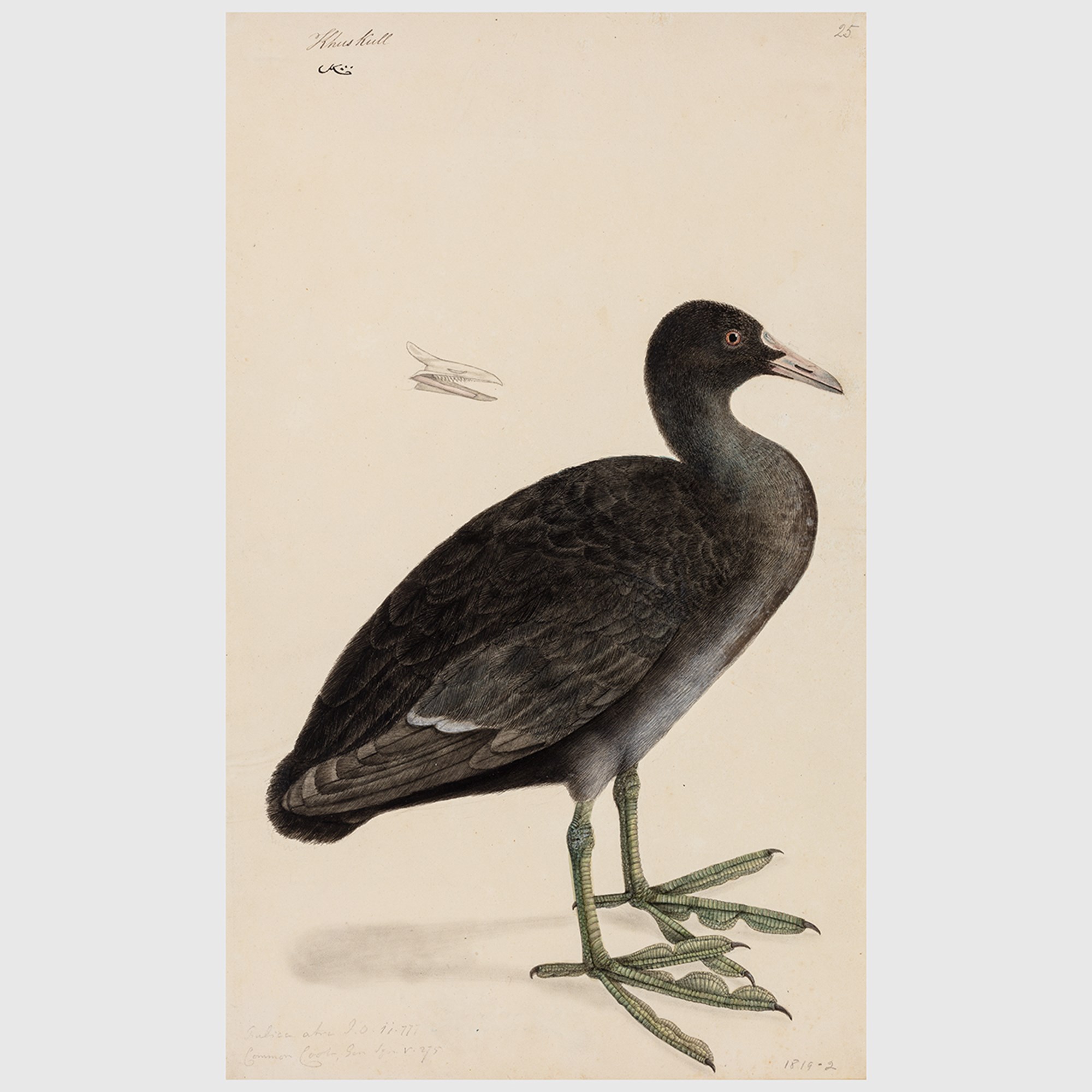A Study of a Eurasian Coot, Fulica atra
Date c.1800
Period Early 19th century
Origin Calcutta, India
Medium Watercolour on unidentified English paper
Dimension 47.5 x 28.5 cm (18³/₄ x 11¹/₄ inches)
The Eurasian Coot is found in Europe, Asia, New Zealand and Australia. They are the most aquatic member of the rail family, which includes moorhens, crakes and gallinules. During migration coots are able to fly remarkable distances, although these long journeys often occur at night where there is less risk from predators.
The present study is an extremely well observed and accurate representation of this intriguing bird. The feathers are predominantly black with grey tinges on the underside of the belly and chest. The bill is white with a murmur of pink and the distinctive frontal shield is typically white. The feet are pale green with a touch of yellow and have been painted with a great deal of care and attention, as the incredible reptile like textures of the skin demonstrate.
Beside the bird appears a detailed study of the beak and shield. The open bill reveals a long narrow tongue and a series of small, sharp teeth. This unusual and insightful feature reminds us that as well as being wonderful artworks, these paintings were also of great scientific interest. At the time these studies were commissioned, there was a great fervour to discover the mysteries of the natural world; to observe, to record and to preserve.
Written in pencil below the bird: ‘Fulica Atra and below this ‘Common Coot.’
For additional ornithological studies made for Lord Valentia, see Sotheby’s Sven Gahlin Collection Lot 36 a drawing of a bustard, and Lot 37 a watercolour of a crow-pheasant, both made for Lord Valentia; Sotheby’s, London, 31 May 2011, The Stuart Cary Welch Collection, Part Two, lot 115; see also Welch 1976, no.26; Welch 1978-I, nos.18a-c.and Leach 1995, no.7.96, pp.760-2. For two bird studies donated by Viscount Valentia to Lord Wellesley, see British Library in London (Wellesley Collection, NHD 29, vol.iv, f.21,27)
Literature
Bikram Grewal et al. 2016. Birds of India - A Pictorial Field Guide. Om Books International.
Stock no.: A5488
Date: c.1800
Period: Early 19th century
Origin: Calcutta, India
Medium: Watercolour on unidentified English paper
Dimension: 47.5 x 28.5 cm (18³/₄ x 11¹/₄ inches)
Provenance:
George Annesley, 2nd Earl of Mountnorris and Viscount Valentia (1769-1844), was a passionate amateur naturalist with a particular interest in ornithology. Following a career in the army, he travelled to India in 1802 where, inspired by his encounters with professional botanists and zoologists, he commissioned a number of natural history paintings.
During his four-month residency with Saadat Ali Khan, Nawab of Oudh (r. 1798-1814), the Viscount was much enthused by the ruler’s additions to his ornithological collection; “he sent people into his woods to bring me rare birds and plants; he laid a dawk two hundred miles to bring them down to me in a state of perfection.” (Viscount Valentia, 1809, p. 172.)
In 1803 he stayed with Lord Wellesley (the elder brother of the first Duke of Wellington) and visited his menagerie in Barrackpore, Calcutta. Viscount Valentia gifted Wellesley two bird studies from his collection, now in the British Library, London (see M. Archer, Natural History Drawings in the India Office Library, London, 1962, p. 96). The works bear his personal Indian seal, “The Right Honourable Lord Bahadur Viscount Valentia.”
Returning to England in 1806, the Viscount became a member of parliament and wrote a three- volume series chronicling his travels, Voyages and Travels to India, Ceylon and the Red Sea, Abyssinia and Egypt in 1802-06. Published in 1809, the books were illustrated by his draughtsman and secretary Henry Salt. Continuing his interest in the natural world, Annesley became a member of the Royal Society and subsequently his collection has become the subject of an important series of natural history studies, celebrating India’s rich ecological biodiversity.
Of the current series of paintings, four bear the Viscount’s personal Indian seal, “The Right Honourable Lord Bahadur Viscount Valentia 1217 (1802-3)”, while three others have a seal in exactly the same ink as the works with a personal seal. Considering this and that the paintings display such a great likeness to one another, it is highly probable that they were commissioned by the Viscount and undertaken by the same artists. Drawing upon Mughal traditions of exceptionally intricate detail, rich colouration and masterful observation, Viscount Valentia’s artists successfully united this with European scientific taxonomy; achieving a sense of harmony between the romantic and the rational. Charming, informative and highly decorative, these works are a valuable example of the finest early nineteenth century Indian ornithological painting.
More artworks from the Gallery









